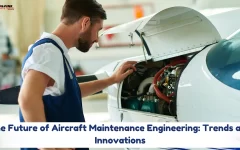Job Opportunities After Completing AME B1.1 Certification: Unlocking Career Paths in Aircraft Maintenance
2024-12-23 7:45Job Opportunities After Completing AME B1.1 Certification: Unlocking Career Paths in Aircraft Maintenance

Job Opportunities After Completing AME B1.1 Certification: Unlocking Career Paths in Aircraft Maintenance
Completing an AME B1.1 certification opens the door to a world of exciting career opportunities in the aviation industry. The aviation sector is rapidly evolving, and with a B1.1 license, which specializes in airframes, engines, and associated systems, you’re well-positioned to enter a field that is not only dynamic but also essential to global transportation.
What is an AME B1.1 Certification?
Before diving into job opportunities, it’s important to briefly understand what the AME B1.1 certification entails. AME stands for Aircraft Maintenance Engineer, and the B1.1 designation specifically refers to engineers who are qualified to work on mechanical systems of aircraft, including the airframe, engines, and associated systems. This certification allows engineers to ensure that aircraft are fit for flight, maintaining strict safety standards and keeping the fleet in optimal operating condition.
Now, let’s look at the vast array of career options available once you’ve completed your AME B1.1 certification.
1. Line Maintenance Engineer
One of the most common entry-level positions for AME B1.1 engineers is working as a Line Maintenance Engineer. Line maintenance involves performing quick, routine checks and minor repairs on aircraft between flights, typically at airports or hangars. Tasks might include:
- Pre-flight inspections to ensure all systems and components are functioning properly before takeoff.
- Turnaround maintenance: Checking aircraft systems during short layovers to ensure they’re ready for the next flight.
- Minor repairs and troubleshooting: Addressing issues like engine performance, electrical malfunctions, and avionics glitches.
Line maintenance engineers work in a fast-paced environment where precision and quick thinking are essential. You’ll be responsible for ensuring that aircraft are safe, reliable, and ready for their next flight.
2. Base Maintenance Engineer
For those who want a more detailed and technical role, a Base Maintenance Engineer position might be a better fit. Base maintenance involves more extensive, long-term work on aircraft, often performed in dedicated hangars or maintenance facilities. Responsibilities include:
- Heavy maintenance checks: Performing detailed inspections and overhauls according to scheduled maintenance intervals (e.g., A, B, C, and D checks).
- Structural repairs: Fixing more complex issues such as corrosion or structural damage.
- Engine overhauls and replacements: Rebuilding or replacing engine components and systems.
- Aircraft modifications: Implementing upgrades or changes to aircraft systems to improve performance, safety, or compliance with new regulations.
Base maintenance engineers have more time to dive into complex repairs and are often specialists in certain systems or types of aircraft. While it can be less fast-paced than line maintenance, base maintenance is essential for ensuring that an aircraft stays airworthy over its entire lifespan.
3. Aircraft Maintenance Planner or Scheduler
An Aircraft Maintenance Planner or Scheduler plays a vital role in the overall operation of an airline or maintenance facility. This role involves organizing and planning maintenance schedules for aircraft, ensuring that they comply with regulatory requirements and that maintenance downtime is minimized. Responsibilities include:
- Coordinating routine checks: Making sure that each aircraft receives the appropriate maintenance at the correct time, in line with the aircraft’s maintenance schedule.
- Managing spare parts inventory: Ensuring the required parts and tools are available for scheduled maintenance or repairs.
- Liaising with other departments: Coordinating with operations, flight crews, and maintenance teams to ensure that aircraft are available and in optimal condition when needed.
This position often requires a strong organizational mindset and an understanding of the operational requirements of airlines, in addition to technical knowledge.
4. Aircraft Engineer in Aircraft Manufacturing Companies
For those who enjoy working with new technologies, aircraft manufacturers like Boeing, Airbus, or smaller regional aircraft companies offer significant career opportunities. As an AME B1.1 certified engineer, you can work on the assembly, testing, and initial maintenance of new aircraft. This could involve:
- Testing newly designed aircraft: Ensuring that newly built aircraft meet safety and regulatory standards before they are delivered to customers.
- Quality control: Overseeing the manufacturing process to ensure that all parts and systems are functioning correctly.
- Collaboration with R&D teams: Working on the testing and implementation of new technologies, such as more fuel-efficient engines or innovative flight control systems.
Working for an aircraft manufacturer allows you to be at the forefront of aviation technology, contributing to the development of the next generation of aircraft.
5. Avionics or System-specific Maintenance Engineer
Though the B1.1 certification focuses on mechanical systems, some engineers may specialize further in specific systems, such as engines, hydraulic systems, or electrical systems. Specializing in one area of aircraft systems can open up new job opportunities in industries like:
- Avionics: Specializing in the maintenance of electrical and avionics systems such as radar, communication equipment, and navigation systems.
- Propulsion and engine systems: Focusing on aircraft engines, working with turbine engines and components to ensure their performance and efficiency.
These specialized roles often require additional training or certification, but they allow engineers to develop niche expertise and command higher salaries in the field.
6. Aircraft Maintenance Manager or Supervisor
As you gain experience in the field, you may progress to managerial or supervisory roles, overseeing teams of engineers or managing maintenance operations at a higher level. In positions such as Maintenance Manager or Team Leader, your responsibilities would include:
- Leading a team of engineers: Coordinating their work, providing guidance, and ensuring safety standards are met.
- Scheduling and resource management: Managing maintenance schedules, tools, and spare parts inventory to ensure smooth operations.
- Ensuring compliance with regulations: Making sure that maintenance activities comply with aviation authorities’ standards (e.g., EASA, FAA, or local aviation authorities).
- Improving efficiency: Identifying areas where the maintenance process can be streamlined or improved.
These roles often require a combination of technical expertise, leadership skills, and experience in the field.
7. Freelance or Contract Aircraft Maintenance Engineer
For engineers who value flexibility or wish to work independently, becoming a freelance or contract aircraft maintenance engineer can be a lucrative option. In this role, you may work with a variety of airlines, private operators, or other organizations on short-term contracts. Responsibilities might include:
- Performing specific maintenance tasks: Offering specialized skills for short-term needs, such as engine repairs, airframe inspections, or structural repairs.
- Traveling for maintenance work: Some freelance engineers work on-site at different airports or facilities, providing their expertise wherever it’s needed.
Freelancing can provide greater control over your work schedule and opportunities to gain diverse experience, but it requires strong networking and business skills.
Job Growth Projections: According to the Bureau of Labor Statistics (BLS) and global aviation industry reports, employment for aircraft and avionics mechanics is expected to grow by 5% from 2022 to 2032, which is consistent with the average for all occupations. Growth drivers include the expansion of air travel, an aging aircraft fleet that requires more maintenance, and the introduction of newer technologies.
Conclusion
Completing the AME B1.1 certification provides numerous career opportunities across various sectors within the aviation industry. Whether you’re interested in hands-on aircraft maintenance, managerial roles, or specialized positions in avionics and propulsion systems, the aviation field offers exciting and rewarding paths. As global air traffic continues to rise, the demand for skilled aircraft maintenance engineers will only increase, ensuring a stable and promising future for AME B1.1 certified professionals.
Your journey as an AME B1.1 engineer is just the beginning, whether you choose line maintenance, base maintenance, or a more specialized or managerial role, there are countless opportunities to grow, diversify your skill set, and advance in this essential and dynamic industry.








